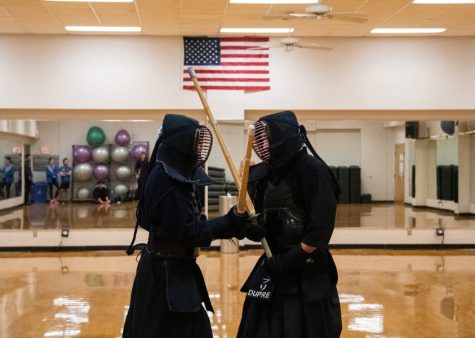Reily Reviews: Finding strength in the sword
January 30, 2019

The Reily Center has introduced Kendo classes, to be held Sundays at 3 p.m.
With all the classes offered by the Reily Center, it can be hard to pick! With this new column, the Hullabaloo offers students a first hand account to help them find the workout they’re looking for.
Last Sunday, I found myself in need of a workout and a change of pace in my usual routine. After perusing the Reily Student Recreation Center’s exercise class list, I decided Kendo, the Japanese art of fencing, could readily offer a solution to both of these pressing issues.
Though Kendo generally requires its participants to purchase their own gear, I opted to partake in a free trial session. Upon my arrival, I was lent a standard Kendo sword, known as a shinai.
Because Kendo was originally developed to preserve Japanese samurai heritage, a kendoka/kenshi, or practitioner of Kendo, must treat their shinai with care, as if they are handling a samurai blade.
Shinai are typically composed of four pieces of bamboo, bound together circularly by small strips of cloth. A long, thick string is stretched along the length of the sword, indicating the top side of the false blade. When practicing and sparring, this string must always face upwards in order to simulate proper blade positioning.
Due to their weight, shinais must be held using both hands. Upon first glance, however, I incorrectly assumed that a bamboo blade would be easy to lift and control. Ten minutes later, I found myself wishing I hadn’t skipped arm day. For those who are interested in trying a rigorous upper-body workout, I would certainly recommend trying to maneuver a shinai.
Sword in hand, a kendoka will attempt to strike four different targets: the top of the head (men), the hips (dou), the upper forearm (kote) or the throat (tsuki). A kenshi must vocalize their intentions by yelling a corresponding Japanese word for each target. Those who fail to properly bellow will not be awarded points, even if their attack is successful.
In addition to alerting the match referees, Kendo vocals are also used to intimidate opponents. As with any form of sports fighting, intimidation can be a deciding factor in any match. After some lackluster attempts to vocalize my attacks, Frank Anselmo, one of the Kendo instructors at Reily, stopped my practice to emphasize this principle.
“If one competitor can create fear or doubt in his competitor’s mind, then that competitor is hindered and becomes nervous and tense,” Anselmo said. “Maybe he will hesitate now, or maybe he can no longer fight so skillfully because he is intimidated. And he is thus mentally beaten.”
With this wisdom in mind, I tried to renew my verbal energy as I attempted the head (men) attack. In keeping with samurai practice, head cuts are expected to be forceful enough to split open an opposing warrior’s helmet if you were to use an actual sword. Given this bit of history, I put more force into my attacks and was eventually deemed ready to strike my first opponent.
For my first match, I was paired with a Kendo expert. Having watched him skillfully assault his opponent minutes before, I was fairly intimidated. Despite my initial bout of insecurity, he was incredibly nice and helpful, which immediately set my anxieties at ease. This, coupled with his protective armor, made me feel comfortable enough to strike him as hard as I could.
Once you give into the swing of Kendo, it can be quite freeing to slash, yell and slide your way to victory. I personally left the class feeling empowered, and could see how Kendo would be an excellent challenge to relieve a busy student’s stress and anger. For those interested in taking the class, junior Steven Milner offers this advice.
“Learn from as many different people as you can,” Milner said. “You get all these little tidbits of knowledge and Kendo wisdom from a bunch of different voices and viewpoints, and it’s really helpful.”
The Kendo class is held every Sunday at 3 p.m. in the Reily Center.









Leave a Comment